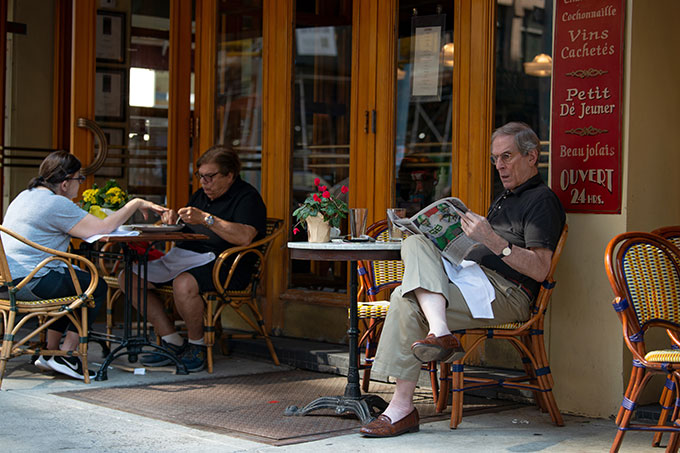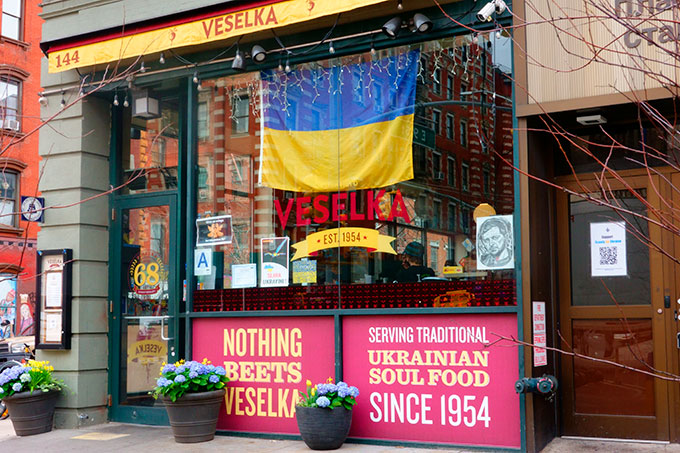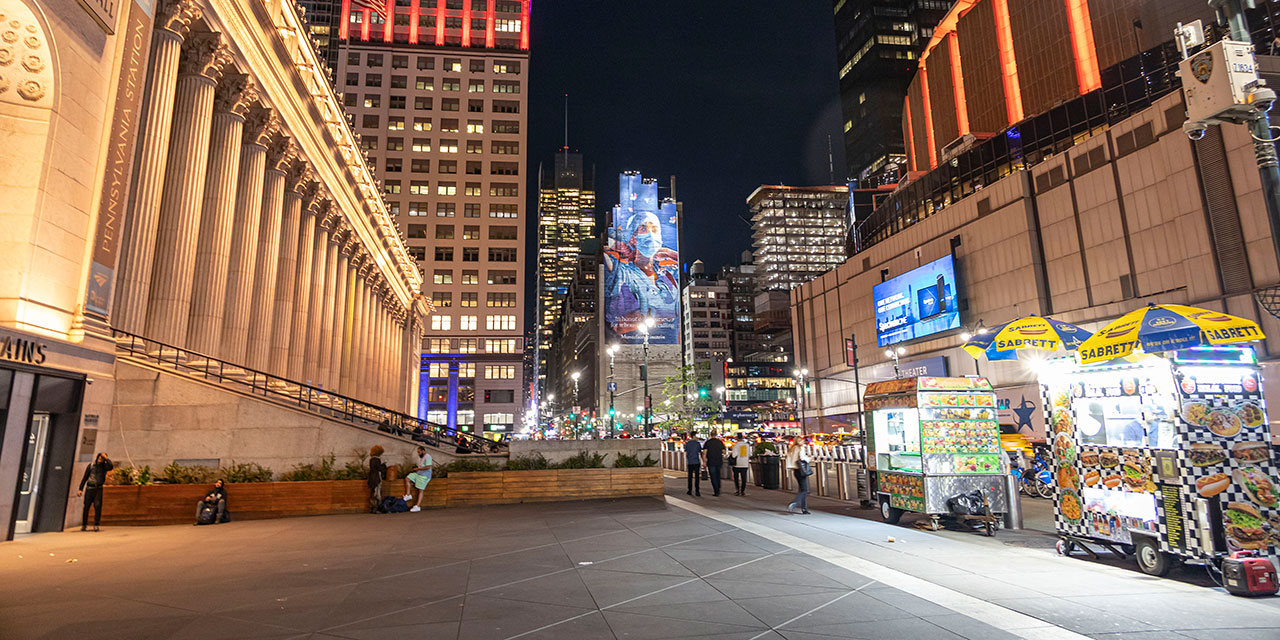On a recent Sunday evening, Imad Khachan encountered a problem once unthinkable in New York City. “I had a friend and his wife visiting from overseas,” says Khachan, the owner of Chess Forum, Greenwich Village’s last remaining chess shop. “They stopped by and said, ‘We’d like to go have dinner around nine o’clock.’ . . . I understand it was Sunday, but we really were hard-pressed to find a place that opened till 10 o’clock, let alone 24 hours. I couldn’t tell them where we [should] go. I felt so embarrassed.”
Khachan’s experience reflects a strange new reality facing New York’s night owls. Across the five boroughs, restaurants and businesses that once opened into the wee hours of the morning shut their doors between 8 and 11 p.m. Late-night coffee shops are all but extinct, and all-night diners are similarly endangered. Khachan’s own Chess Forum, open 24/7 for decades, now closes at midnight.
Finally, a reason to check your email.
Sign up for our free newsletter today.
When did New York become the city that sleeps? The shift began at the height of the Covid-19 pandemic, when the city forced restaurants and bars to close. Nearly 1,000 never reopened, and five years after the pandemic’s inception, many that did survive have not returned to their old hours. Their owners cite various factors.
From its founding in 1964 until 2020, Sarge’s Delicatessen was open 24/7. Even a 2012 fire that forced the business to close until 2014 couldn’t deter owner Andrew Wengrover from serving overstuffed pastrami sandwiches through the night. But in 2021, he began closing at 10 p.m. New York’s pandemic-era decline discouraged him from returning to the old model.
“Employees really started to not feel safe getting on the subways late at night, walking around the city,” Wengrover said. “The city definitely isn’t what it used to be.”
Even if crime were eradicated in New York, Wengrover would only slightly extend his hours. “I don’t miss getting phone calls at three o’clock in the morning that people are pulling the fire alarms and all this stuff,” Wengrover said. “I also don’t live as close [to the store] as I used to. I’d like to be open later than 10 o’clock. But I’m okay not being 24 hours.”
Sarge’s is a Murray Hill institution, but Wengrover thinks a 24/7 establishment is out of step with the neighborhood’s future. “Everything’s closing. They’re building all these high-rises,” he says. “If it was maybe more of a commercial situation, it would have been an easier decision.”
It’s a similar story on the Upper West Side, where nightclubs and bars have been largely supplanted by luxury residences. This cultural shift led French Roast, a longstanding neighborhood bistro formerly open 24 hours, to close its doors at 10 or 11 p.m. each night.
“There simply isn’t the demand for us to be open,” said general manager Sam Belanger. “We would be operating at a loss for the late-night hours.”
Belanger has no plans to expand the hours “unless late night venues and attractions return to the Upper West Side.” He also considers the protean nature of New York’s restaurant scene a continual challenge.
“New Yorkers love their memories of the past and are always sad when landmark restaurants change or close,” Belanger said. “But they need to ask themselves, ‘When was the last time I was there?’ [A] visit for nostalgia every five years or so cannot support a restaurant, so the restaurant needs to reinvent itself.”
French Roast isn’t the only bistro to stir up wistful feelings among New Yorkers. L’Express opened in Gramercy Park in 1996 and operated 24 hours a day until the pandemic. Since reopening in 2021, its hours have steadily extended; it now closes at 4 a.m. on Fridays and Saturdays, 2 a.m. on Wednesdays and Thursdays, and midnight from Sunday to Tuesday. But according to Torris Pelichet, a brand and business strategist for the restaurant, it’s unclear whether it will resume full 24-hour service, despite customers’ frequent inquiries.
 Photo by Alexi Rosenfeld/Getty Images
Photo by Alexi Rosenfeld/Getty Images
“I think New Yorkers were a little bit more hardcore before the pandemic,” Pelichet said. “You would see a lot of the business folks, the white-collar guys at a bar until 2 or 3 a.m. on a Wednesday. And then they’ll wake up early in the morning to go to work. And I think the pandemic just changed a lot of that stuff. And maybe people don’t value that kind of lifestyle anymore.”
Pelichet notes that the ease of online delivery and the unsteady state of the economy have made expensive late-night dinners less attractive to consumers. The endurance of remote work has cost the restaurant clients who once worked in nearby offices. Still, Pelichet hopes that L’Express can return to its old hours eventually.
“We need to go over our historical data,” he said. “We need to identify and pinpoint some of the people who create 80 percent of the value for our company. And then we need to break them down demographically and psychographically and understand exactly who they are, what their behaviors are, and what they’re interested in and what they like. And through our analysis and our research, if we do find that it’s a smart business move to open back up 24 hours, then obviously we would do that.”
For other restaurants, the obstacle to nonstop service isn’t a lack of customers but a lack of employees. At Veselka, a Ukrainian staple in the East Village, owner Jason Birchard is eager to open around the clock, as he did before the pandemic. But finding workers who share his enthusiasm has proven difficult.
 Photo by Joan Slatkin/UCG/Universal Images Group via Getty Images
Photo by Joan Slatkin/UCG/Universal Images Group via Getty Images
“There’s just a lot [fewer] people in the workforce that are looking for hospitality jobs,” Birchard said. “It’s a struggle at times to just find the staff for the regular hours, to be honest.”
Birchard offers a few reasons for the staffing shortage. Among them are immigration restrictions and the advent of Zoom, which has allowed struggling actors, many of whom would have once waited tables, to audition for roles remotely without moving to the city. But for the most part, he’s bewildered by the lack of available help.
“My hiring manager is constantly telling me that it’s just really slim pickings out there,” he said. “And I’m not a fly-by-night place. There are benefits that I offer. And working in a place that’s got a 70-year history, you think there’s going to be some pride to work in this type of . . . establishment.”
Nevertheless, he remains optimistic that things will recover. “Right before Covid, I remember being here at 3 a.m. working on one of those shifts. And it was just as busy, if not busier, at 3 a.m. than it would be at three in the afternoon on a busy weekday or weekend. Obviously, there’s a lot of allure, a lot of promise to be open late at night. People enjoy a quality meal.”
Stratis Morfogen would certainly agree. He’s the founder of Diner 24, which opened in Gramercy Park in May 2024 with 24-hour service as a primary selling point. So far, the model has succeeded.
“Diner 24 has tripled my projections. We do about 6,000 customers a week,” Morfogen said. “And the funny thing is, our busiest five hours are midnight to five. There’s a line out the door Thursday, Friday, Saturday.”
How has Morfogen achieved this as other businesses struggle to attract patrons? He stresses the importance of online marketing.
“The bigger problem with our industry is that they’re not embracing technology, search engine optimization, and really working on viral content,” he said. “When you create viral content, and one of your videos goes viral, you could fill up a treehouse in Antarctica.”
Morfogen optimizes his site design to keep Diner 24 at the top of Google search results. He also produces promotional content on TikTok, Instagram, and other platforms. These measures have helped Diner 24 catch the eye of tourists from Europe to New Zealand.
“They have a plan to come to the U.S. or visit New York City,” Morfogen said, “and we’re on their hit list.”
For New York once again to become the city that never sleeps, its businesses will have to follow Morfogen’s lead. Even amid cultural shifts, the local appetite for late-night living hasn’t been sated. The companies that cater to this pent-up demand will shape Gotham’s revival.
Top Photo by Nicolas Economou/NurPhoto via Getty Images
